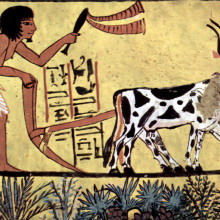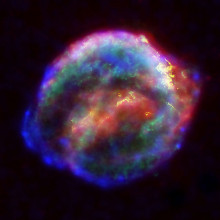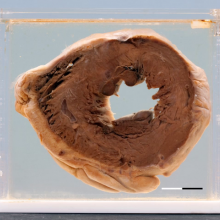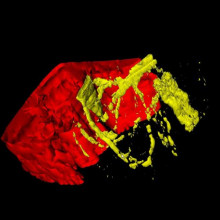Farming, Flying and Inflamed Hearts
In this NewsFlash, we hear how farming migrated across Europe, how distant supernovae affect diversity of life on Earth, and the role of DNA and inflammation in heart failure. Plus, we home in on the parts of the pigeon brain responsible for sensing magnetic fields...
In this episode

00:17 - Farming moved with ancient migrants
Farming moved with ancient migrants
One of the great questions in archaeology, "did farming move across Europe through the spread of knowledge or people?" now looks somewhat closer to being answered.
Researchers at The University of Uppsala in Sweden have this week published a report that indicates it was the migration of people that brought farming to the continent.
 The adoption of farming is seen as one of the great stepping stones in human development. It allows more people to live off smaller areas of land, supporting a population with time to do other things like build impressive monuments and develop new technologies. Across the world there are several areas where agriculture has its origins, and the closest one to Europe is in the Near East, where it's thought farming started around 11,000 years ago.
The adoption of farming is seen as one of the great stepping stones in human development. It allows more people to live off smaller areas of land, supporting a population with time to do other things like build impressive monuments and develop new technologies. Across the world there are several areas where agriculture has its origins, and the closest one to Europe is in the Near East, where it's thought farming started around 11,000 years ago.
Farming took around 6,000 years to move across Europe, but in order to work out how that spread occurred, archaeologists have several clues to work on. The usual lines of evidence are ceramics, technology and language. But the Swedish team, led by Pontus Skogland, looked at the problem using the DNA of four 5,000-year-old individuals. One of these was a farmer, buried on the Swedish mainland, while the other three were hunter gatherers that were excavated on the island of Gotland, 250 miles away.
What they found was that the two groups of people had quite different markers for their origins. The hunter-gatherers shared much of their genetics with modern Finnish populations, and the farmer shared a greater proportion of his DNA with Mediterranean populations of today. This implies that the farmer was a migrant, or at least a descendant of migrants, and that European hunter-gatherer populations were replaced, to some degree (there was probably some admixture).
It looks like farming was indeed spread along by a movement of people rather than a simple transmission of culture and knowledge, and that this has affected the genetic diversity present in Europe today. You can find out more about that story in the journal, Science.

02:55 - Diversity of life down to distant supernovae
Diversity of life down to distant supernovae
The timings of supernova explosions close to Earth marry up with epochs in the planet's history when the diversity of life altered dramatically, suggesting they may  have played a role in driving evolution.
have played a role in driving evolution.
Species diversity on Earth has varied significantly over the last 4 to 500 million years; and although it is hard to measure this in larger animals, looking at the number of genera of well-preserved marine organisms within the fossil record, it rises rapidly to about 250 million years ago, then drops rapidly by about 200 million years ago and then increases again over the last 100 million years or so.
Geologists have used plate tectonics to account for these trends, arguing that this alters sea-level and atmospheric chemistry and in turn the temperature. The overall effect, they argue, is more shallow seas, giving rise to more complex coastlines and a more varied marine environment. So you would expect more diversity of species.
But this may not be the whole story. Henrik Svensmark has been looking at a different source to explain the changes: supernovae, the explosions that punctuate the end of a star's life, producing in their wake powerful surges of cosmic particles and radiation. For now, he's confined his analysis to events that have occurred within about 5000 light years of Earth.
To spot where and when they may have happened, he looked for stellar congregations called "open star clusters", where star-forming events have occurred in the recent past. He reasoned that, if stars were forming in these places, some of them will have been the short-lived massive stars that form supernovae.
Comparing these predictions with records of cosmic rays preserved in meteorites produced a strong agreement. He then compared the cosmic ray records from the last five hundred years with the numbers of marine species. The match is striking. There are peaks 250 million years ago, and again now.
Svensmark speculates that high energy particles issusing from the supernovae could have entered Earth's atmosphere where they produced trails of ions that seeded clouds, cooling the planet and boosting species diversity. Consistent with this theory, when he looked at previously-unexplained rapid cooling events that have hit the planet in the past, there was again a strong correlation with the supernova data.
So, surprising as it sounds, life on Earth may owe its origins not just to our nearest star, the Sun, but also to the deaths of other stars thousands of light years distant...

05:42 - Rogue DNA at the heart of cardiac failure
Rogue DNA at the heart of cardiac failure
DNA released by damaged heart cells triggers inflammation and cardiac failure, new reseach has shown.
Writing in Nature this week, Kings College London researcher  Kinya Otsu and his colleagues first demonstrated, using animals with heart failure, that DNA accumulates in the affected cardiac tissue.
Kinya Otsu and his colleagues first demonstrated, using animals with heart failure, that DNA accumulates in the affected cardiac tissue.
Knocking out the enzyme Dnase2a, which breaks down redundant DNA in cells, also produced mice prone to fatal heart failure. Studies on the animals' failed hearts also showed a dense infiltration of the tissue with immune cells, and the accumulation in the cells of pieces of DNA that appeared to be in the process of being broken down.
But the DNA wasn't from the nucleus, the team found. Instead it was from the mitochondria, the structures inside cells that burn fuels to produce energy. Mitochondria are originally descended from primitive bacteria, which teamed up symbiotically with cells over a billion years ago, providing energy in return for shelter and protection.
The evidence for this relationship is that mitochondria still contain their own DNA sequences, and like the bacteria from which they are descended this DNA is circular. And because it resembles bacterial DNA, this mitochondrial DNA can also triggers an immune response by binding to anti-bacterial detectors called Toll-like receptor 9 (TLR-9) receptors on immune cells.
The stress of heart failure, it seems, causes the cardiac cells to accumulate rather than break down this DNA from their defunct mitochondria. The ensuing inflammation further stresses the tissue, exacerbating the heart failure.
Predictably, knocking out TLR-9, or blocking it with a drug, reduced the severity of the heart failure.
According to Otsu, "When mitochondria are damaged by stress, such as during heart failure, they become a problem because their DNA still retains an ancient bacterial fingerprint that mobilises the body's defences."
Blocking this effect in humans, the scientists speculate, could hold the key to future treatments for a condition affecting three quarters of a million people in the UK alone.

09:55 - How pigeons pick up Earth's magnetic field
How pigeons pick up Earth's magnetic field
Scientists have detected the parts of a pigeon's brain that enable it to use the Earth's magnetic field to navigate.
That birds such as pigeons, as well as a host of other animals, are sensitive to magnetic fields and might use them like a cognitive compass to find their way around has been known for some time; but how they detect and then process this information neurologically has remained a grey area.
Now, working with homing pigeons, two researchers from Baylor School of Medicine in Texas, Le-Qing Wu and David Dickson, have identified the parts of the bird brain responsible.
Writing in Science, the duo first exposed pigeons to a changing magnetic field and then looked in the animal's brains for nerve cells that had increased their expression of a gene called c-Fos which is linked to neural activation.
Four areas lit up: the lateral hyperpallium, hippocampus, dorsal thalamus, and caudal vestibular nuclei. These regions are are all known to be involved in navigation functions and in spatial orientation.
Next the researchers used electrodes to record nerve activity in one of these regions, the vestibular nuclei, in seven pigeons.
The animals were tested in the dark to avoid giving them light-related cues. A set of coils were used to generate a magnetic field that cancelled out the planet's natural field and then applied its own.
The researchers varied the orientation of this field, which was equivalent in strength to the Earth's own magnetic field, in 10 degree steps. They were able to show that the cells displayed a "tuning curve" of activity, responding most in some orientations and least in others.
How the birds actually detect the magnetic field in the first place isn't known for sure, but the researchers have so far homed in on a structure called the lagena in the inner ear, which they plan to look at next, although the beak and retina could also be involved.

15:38 - 3D Tissue Imaging and Subordinate Meerkats
3D Tissue Imaging and Subordinate Meerkats
Derek Magee, University of Leeds; Jacqueline Crawley, National Institue of Mental Health; Sobnath Baidya Roy, University of Illinois;
3D Imaging of Human Tissue
High resolution
3d images of human tissues can now be created using a technique developed by scientists at the University of Leeds.
By scanning hundreds of slides of sliced tissues segments at once and converting them into high resolution digital images, the software, developed by Derek Magee, then aligns these to produce detailed, multi-coloured images in 3 dimensions, with over 400 created to date.
The technique can be used on numerous tissue types including tumours and samples of liver disease, and enables samples to be rotated on a computer screen and monitored from any angle.
Derek - Within a human body, some things are inherently 3D structures and looking in the 2D does not give you the same information. So take as an example blood vessels, blood vessels are a branching structure of tubes. If we cut a tube as a 2D section, all you see is an ellipse. So if you look at a blood vessel in 3D, you can actually see this branching structure and you can relate it to the structures around it. For example, a tumour, if that's very close by you can see, well, has that tumour got its own blood supply or is it a very early stage tumour that is yet to develop its own blood supply?
---
New compound to treat Autism
A drug to treat the symptoms of autism has been identified by scientists at the National Institutes of Mental Health in the US.
Working with inbred mice displaying signs of autism such as unusual social interactions, excessive jumping and repetitive self-grooming, Jacqueline Crawley and colleagues found that when the mice were injected with the
compound GRN-529 - which regulates glutamate release in the brain - these behaviours were significantly reduced.
Jacqueline - Treatment with this compound that reduces excitatory glutamate neurotransmission in the brain reduces repetitive behaviours, reduces stereotype jumping, and improves some of the social deficits that are seen in these mice. We may be able to develop pharmacological treatments that might be beneficial to children and adults who have autism. The challenge of course is to find compounds that will be effective in people, but it's one of the most promising leads that we've seen for quite a long time.
---
Climate warming by wind turbines
Large wind farms may be affecting local weather and climate in the US.
With the US wind industry growing rapidly in recent years, scientists at the University of Illinois analysed satellite data for the land surface temperatures of four of the World's largest wind farms in Texas, to see their effect on local land surface temperatures from 2003 to 2011.
The team found a warming effect of up to 0.72 °C per decade when compared to nearby regions lacking these farms.
Somnath Baidya Roy co-authored the study.
Somnath - Turbulence generated by the spinning of the wind turbine rotors mixes air up and down, and the key impact of this is a warming effect near the surface and on the land surface at night. Now, wind power does not generate almost any carbon dioxide emissions and hence, wind power is going to be a part of the solution to the climate change problem. Understanding the impacts of wind farms will help us develop efficient adaptation and management strategies and thereby contribute to a long term sustainability of wind power.
---
Subordinate Meerkats are the best problem solvers
And finally, subordinate members of a meerkat social group are the best at solving problems.
Alex Thornton from the University of Cambridge set tasks for 7 groups of wild meerkats where the animals were required to open or break into transparent containers to reach the scorpion supper located inside.
The team found that lower ranking members of the group, and particularly males at this rank, were the most successful at solving the task.
Alex - The reason for this is probably that these individuals are unable to outcompete others. So unlike their dominants, they can't bully their way to get food rewards. So, there are advantages for them to try and find out new ways of solving problems. For the males, this is particularly advantageous because they're the sex that disperses, that goes out to seek mating opportunities, so they're going to be encountering new difficulties in the world and so it will make sense for them to try and find out ways of solving new problems.
And that work was published in the journal Animal Behaviour.










Comments
Add a comment